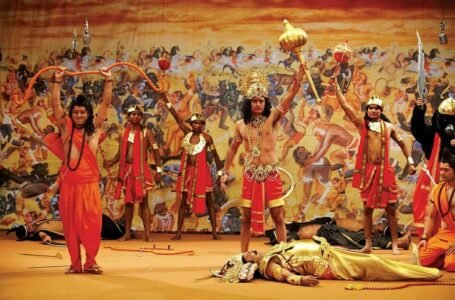The Forgotten Form of Shiva: Sarabha

Shiva, the destroyer, the cosmic dancer, and the eternal force of transformation, has countless manifestations in Hindu mythology. Among these, one of the most intriguing and lesser-known forms is Sarabha, a powerful avatar that emerged to subdue the wrath of Lord Narasimha. This blog delves deep into the origins, significance, and forgotten glory of Sarabha, the divine protector and supreme force of Shiva.
वरम्या ये महामाय विश्वमूर्तिनो यता
(Varmya Ye Mahamaya Vishwamurtino Yata)
“He who is the Supreme Protector of the Universe, who assumes various forms for cosmic balance, we bow to Him!”
Origins and Meaning of the Name ‘Sarabha’
The name Sarabha (Sanskrit: सरभ) is believed to have originated from ancient scriptures, describing a mythological creature that is a combination of a lion, bird, and human. The word “Sarabha” is often associated with strength, agility, and supreme divine power.Sarabha is depicted as an eight-legged, multi-winged, fierce being with sharp claws and an aura that radiates unstoppable energy. This form was born from Shiva’s divine will when he saw that Lord Narasimha’s fury was uncontainable even after slaying Hiranyakashipu.
Why Did Shiva Take the Form of Sarabha?
The legend of Sarabha finds its roots in the famous tale of Lord Narasimha, an incarnation of Vishnu, who descended to slay the demon king Hiranyakashipu. However, after his victory, Narasimha’s rage remained unchecked, threatening the cosmic balance. Devas, Rishis, and even Lord Brahma feared the destruction that Narasimha’s uncontrollable wrath could bring.
In response to the prayers of the gods, Lord Shiva manifested as Sarabha—a being so powerful that even the mighty Narasimha had to surrender. Sarabha embraced Narasimha in his massive wings, absorbing his fury and restoring peace to the universe. This event signifies that even the fiercest forms of divinity require balance, and Shiva, as the supreme force, ensures cosmic order.
न मृत्युर्नमिधिकृतिं शिवमिहन्त्यमोगेन
(Na Mrutyurmihikrutim Shivamihantyamogen)
“Death has no power over those who surrender to Lord Shiva, for he is the eternal destroyer and protector!”
Who Worshipped Sarabha?
Sarabha was primarily worshipped by Shaivites, especially in the regions of Tamil Nadu, Andhra Pradesh, and Karnataka. The Shaiva Agamas mention the Sarabha Upasana, a form of Shiva worship practiced by saints and devotees seeking protection and divine strength.
Certain sects of Brahmins, Kshatriyas, and warrior clans also revered Sarabha as the protector of righteousness. In some traditions, tribal communities who believed in the worship of ferocious and guardian deities incorporated Sarabha into their rituals.
Where Were Sarabha Temples Located?
Though Sarabha is a forgotten deity, his presence was once widespread across ancient India. Some of the known temples dedicated to Sarabeshwara (Shiva as Sarabha) are:
- Kshiraramam Temple, Andhra Pradesh
- Tiruvannamalai, Tamil Nadu
- Sri Sarabeswarar Temple, Tamil Nadu
- Sri Kalahasteeswara Temple, Andhra Pradesh
- Sri Sarabeshwarar Temple, Kudumiyanmalai, Tamil Nadu
These temples, though lesser-known, hold great spiritual significance and reflect the lost grandeur of Sarabha worship.
How Did Sarabha Defeat Narasimha?
Shiva, in the form of Sarabha, appeared before Narasimha, who was still roaring in divine rage. Sarabha’s form was overwhelming—his massive wings covered the sky, and his sharp claws radiated energy. As Narasimha attempted to fight, Sarabha lifted him in the air and embraced him with his wings. This act absorbed Narasimha’s uncontrolled energy, calming him and restoring Vishnu’s divine form. This story is symbolic of the fact that Shiva is the ultimate force that can neutralize any excess energy, restoring balance in the universe.
नमाहं शिवाय
(Namah Shivaya)
“I bow to the Supreme Lord Shiva, the source of all creation, destruction, and transformation!”
Why is Sarabha a Forgotten God?
Despite being an extraordinary form of Shiva, Sarabha has been gradually erased from popular Hindu consciousness. Some reasons for this include:
- Rise of Vaishnavism – Certain sects of Vaishnavism opposed the idea of Shiva overpowering Vishnu’s form.
- Limited Mentions in Texts – Over time, texts focusing on Sarabha worship were overshadowed by mainstream Puranic literature.
- Decline of Regional Worship – Many temples dedicated to Sarabha were either destroyed or converted into Shaivite temples dedicated to other forms.
However, some Shaivites still acknowledge Sarabha’s supreme power and celebrate his role in maintaining cosmic balance.
CURSE ON SARABHA :-
According to certain Shaiva and Vaishnava traditions, after Sarabha subdued Narasimha, some sages and Vishnu’s devotees saw it as an act of aggression against Lord Vishnu. To prevent further discord between Shaivism and Vaishnavism, a curse was placed upon Sarabha that he would no longer be worshipped widely. This was meant to restore harmony among devotees of both deities.
Additionally, it is believed that Shiva himself absorbed Sarabha back into his supreme form, signifying that Sarabha’s purpose had been fulfilled, and he was no longer needed in the cycle of cosmic events. This resulted in the gradual disappearance of Sarabha’s temples and his worship from mainstream Hindu practices.
Did Sarabha Improve After the Curse?
Since Sarabha was none other than Lord Shiva, he was beyond improvement or degradation. However, the form of Sarabha was withdrawn to maintain peace among sects. Rather than considering it an act of punishment, it was seen as a necessary step to balance devotion and prevent conflict between Shaivites and Vaishnavites. Although Sarabha’s independent worship declined, he still remains a significant figure in certain Shaivite traditions and temple sculptures, reminding devotees of Shiva’s ultimate control over cosmic balance.
Teachings of Sarabha
Sarabha’s manifestation carried deep spiritual teachings:
- The Supremacy of Detachment: Sarabha represents the transcendental nature of divinity, teaching that all emotions—be it anger, power, or devotion—must be balanced to attain liberation (moksha). Even a mighty god like Narasimha had to submit to the higher force of Shiva.
- Control Over Ego and Pride: The myth signifies that even the most powerful beings must surrender to divine will. Narasimha’s uncontrollable rage symbolized the dangers of pride and ego, while Sarabha’s intervention demonstrated the importance of self-restraint and humility.
- Harmony Over Destruction: Sarabha did not destroy Narasimha but transformed his energy into a peaceful form, teaching that true power lies in transformation, not destruction. This concept is central to Shaivism, where Shiva is both the destroyer and the benevolent protector.
- Divine Grace and Protection: Devotees believed that worshipping Sarabha could grant them protection from destructive forces, both external and internal. He symbolizes the power of Shiva to calm the storms of life and bring peace.
Why Did People Worship Sarabha?
In ancient times, Sarabha was revered as a protector deity, especially among Shiva devotees. People believed that worshipping him would:
- Shield them from uncontrolled anger, negative emotions, and destructive energies.
- Help them gain control over their own pride and ego.
- Bestow spiritual wisdom and grant moksha.
- Offer protection against dangers, diseases, and enemies.
Worshippers would perform Sarabha Kavacha Stotra and Sarabha Upasana to seek his blessings, often praying for emotional stability, wisdom, and divine protection.
How Did Sarabha Fulfill Devotees’ Wishes?
It is said that meditating upon Sarabha or chanting his sacred hymns would bring peace, inner strength, and divine intervention during hardships. Temples dedicated to Shiva in his Sarabha form were places where people sought guidance and solutions to overwhelming problems, just as Shiva had subdued Narasimha’s fury.
Thus, Sarabha stands as a symbol of divine balance, teaching humanity the importance of wisdom, humility, and control over destructive emotions.
Reviving the Forgotten Glory
As true devotees of Lord Shiva, it is our duty to remember and honor all his manifestations. Sarabha is not just a myth but a symbol of divine control, balance, and ultimate protection. Let us spread awareness of this mighty form of Shiva and bring back the lost glory of Sarabha in our prayers and devotion. May the fierce yet compassionate presence of Sarabha bless us all! Har Har Mahadev!


